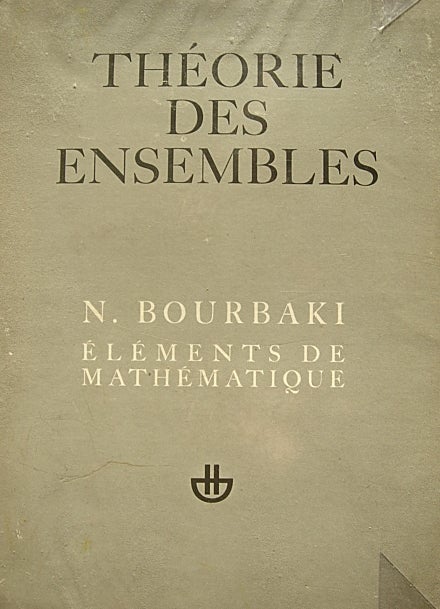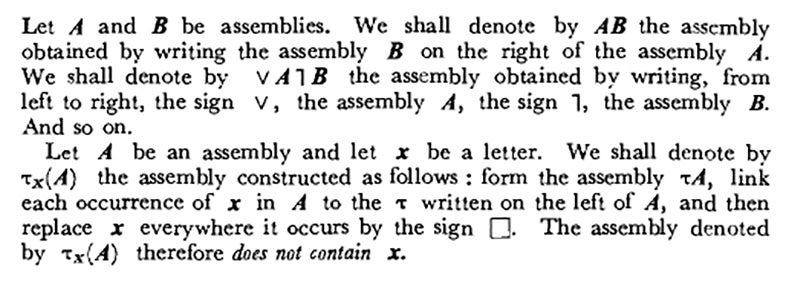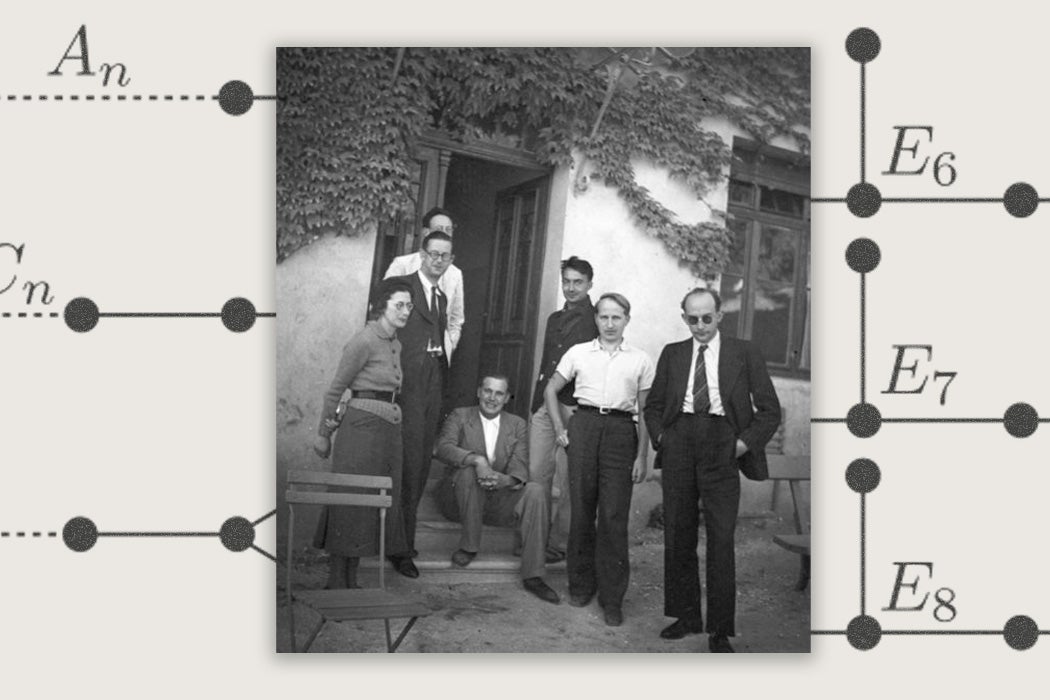In 1935, one of France’s leading mathematicians, Élie Cartan, received a letter of introduction to Nicolas Bourbaki, along with an article submitted on Bourbaki’s behalf for publication in the journal Comptes rendus de l’Académie des Sciences (Proceedings of the French Academy of Sciences). The letter, written by fellow mathematician André Weil, described Bourbaki as a reclusive author passing his days playing cards in the Paris suburb of Clichy, without any pretense of overturning the foundations of all of mathematics (that more disruptive part of Bourbaki’s oeuvre and ambitions would come later). On the strength of Weil’s recommendation, Cartan helped launch what would become one of the most storied and notorious careers in the history of mathematics.
Weil, for his part, was playing a prank, propagating an elaborate in-joke that continued among mathematicians for decades. The math was real. Nicolas Bourbaki was not.
Weekly Newsletter
Bourbaki’s oeuvre, among the most cited and celebrated contributions to twentieth-century mathematics, was planned and written by a brazen collective of scholars. Initially based in France, with a somewhat shifting membership, the founding group was dominated by alumni of the École normale supérieure, a storied training ground for French academic and political elites. They were united by an international outlook, often cultivated in early scholarly experiences abroad, and a conviction that French mathematics was due for a forward-looking generational shift.
As the collective imagined him, Bourbaki would be gnomic and mythical, impossible to pin down. His mathematics would be just the opposite, absolutely unified, unambiguous, free of human idiosyncrasy. Bourbaki’s Elements of Mathematic—a series of textbooks and programmatic writings first appearing in 1939—pointedly omitted the “s” from the end of “Mathematics” as a way of insisting on the fundamental unity and coherence of a dizzyingly variegated field.
The method Bourbaki’s collaborators developed to bring unity to mathematics was a time-honored tactic for producing social cohesion: an elaborate inside joke. The tactic may at first seem out of place in cold, formal mathematics, where cohesion ought to come from austere and unequivocal deductions open to everyone. But even in mathematics, it’s more fun to be in a club with barriers to membership. In fanciful and pun-filled narratives shared among one another and alluded to in outward-facing writing, Bourbaki’s collaborators embedded him in an elaborate mathematical-political universe filled with the abstruse terminology and concepts of modern theories.
In their world of mathematical wordplay, prank, and parody, earth-shaking ideas could come from anyone and anywhere, but tended in practice to come from rambunctious elite French men who could get the references and weave in their own. Bringing more and more mathematicians into the joke, they built an extended community dedicated to radically rethinking how mathematics should be done.

To make rigorous mathematics out of a shared joke, Bourbaki’s Elements of Mathematic took a decades-old philosophical consensus and gave it a twist. The existing line of thought held that making mathematics unambiguously, absolutely, incontrovertibly solid was ultimately a problem of language. To produce rigorous mathematical proofs, one needed a surefire way to guarantee that the proofs’ language was free from the unaccountable variations of human thought and perception. If everyone could just absolutely and forever agree about what they were talking about, the rest of the math would safely sort itself out.
Like those before him, Bourbaki insisted on setting mathematics in a “formalized language” with crystal-clear deductions based on strict formal rules. When Bertrand Russell and Alfred North Whitehead applied this approach at the turn of the twentieth century, they famously filled over 700 pages with formal symbols before establishing the proposition usually abbreviated as 1+1=2. Bourbaki’s formalism would dwarf even this, requiring some 4.5 trillion symbols just to define the number 1.
The twist came from Bourbaki’s intention to “very quickly abandon formalized mathematics, but not before we have carefully traced the path that leads back to it,” as explained in the volume Theory of Sets. Through a careful process of cultivating what Bourbaki called “abuses of language,” mathematicians could avail themselves of the creative ferment of informal reasoning while staying true to the certainty of formal deduction. In other words, like prank-loving schoolboys, they could cleverly break the rules and have their fun while being sure not to get caught in a fallacy. Abuses of language would be common informal understandings that witting mathematicians could share freely and fruitfully, like an inside joke, provided they all knew not to take them too seriously. Everyday mathematics became a kind of logical deadpan.
Mathematically, Bourbaki’s basic ingredients were “signs and assemblages”: arbitrary but unambiguous written symbols and clearly demarcated ways of putting them together to create new meanings. This process of making meaning could appear deflatingly mechanical and pedantic: write signs next to each other, join them together with lines, replace some signs with others, draw new links according to a fixed rule, rewrite, rewrite again, ad nauseum. The path from here to the creative brilliance of the most exciting mathematical theories was hard to picture and practically impossible to tread step by step. But by carefully marking how to walk this path and systematically building up provisional abbreviations and shorthand, one could claim the rigor of mind-numbing sign-and-assemblage work simply by imagining how it would go, if one had the time and patience to spare for it.
Socially, Bourbaki’s practices were anything but clear, mechanical, or universally inclusive. Their boisterous and alcohol-fueled meetings regularly dissipated into shouting matches and involved a fair amount of hazing toward new recruits. These Bourbaki “congresses,” often in scenic locales in the French countryside, were notably exclusionary. Women, rarely allowed to join the mathematical sparring even informally, were occasionally lumped with townspeople and farm animals as “extras” in the meetings’ pun-filled and sometimes ribald official accounts.
For those in the know, part of Bourbaki’s allure was the idea of a secret society committed to principles of radical collectivity in their thinking and writing, selflessly sacrificing their individuality to a standard-bearing pseudonym. This, too, was part of the joke. Many fans of Bourbaki were entirely ignorant of the particular mathematicians who wrote his texts, but it was not unusual for mathematicians to know at least some real names behind the fake one. Their mythologized writing process, based on searing interrogation and exacting egalitarian consensus, likewise, was understood to be more an ideal than a consistent practice.

Partial knowledge of alleged secrets about membership and methods brought a large community of adopters and advocates into the fold, helping them feel a part of a project bigger than themselves. Meanwhile, Bourbaki’s status as an open secret let the collaborators reap the prestige of being associated with an important foundational project while avoiding questions about who they included—and what right they as individuals had to stake such brash claims about mathematical truth and method.
Bourbaki’s most enthusiastic fans took the joke and ran with it. Early on, before the Elements of Mathematic started to appear, Weil shared the Bourbaki collaborators’ ambitions and culture of games and wordplay with a group of young mathematicians in Princeton, New Jersey. Thrilled and inspired, they created their own pseudonym, E.S. Pondiczery, and attributed to him a number of articles and a large volume of reviews. In their zeal for pseudonyms, they gave Pondiczery a pseudonym of his own, H.W.O. Pétard, to whom they attributed their more explicitly parodic writing. The Bourbaki and Pondiczery communities crossed paths regularly and integrated their pseudonyms into shared worlds, even printing elaborate pun-filled invitations for a wedding between Pétard and Bourbaki’s daughter Betti (from the surname of a famous Italian geometer).
Many did not get the joke, taking Bourbaki’s dense formalism too seriously and thereby missing the import of the intervention. For those who believed Bourbaki’s goal was to replace informal mathematical thinking with cold manipulations of signs and assemblages, Bourbaki’s aims certainly seemed preposterous, especially when extended beyond the walls of mathematics departments. Famously (or notoriously), the New Math reform of primary and secondary mathematics education in the 1960s, inspired by Bourbaki’s project, baffled and outraged parents and educators who didn’t see why mathematicians thought small children ought to learn the abstract theory of sets along with their sums and figures. Quite a few mathematicians understood the joke well enough, but disagreed with Bourbaki’s priorities, worrying that they undervalued applied mathematics or mainly offered window dressing to existing methods that were working just fine without them.
Many more were never meant to be included in the joke. Bourbaki courted and depended on the support of selected senior mathematicians, such as Cartan, as well as International Mathematical Union founder Marshall Stone. But they mostly wrote off older generations as squares who lacked the youthful perspective, dexterity, and ambition to get with the program. The old guard wrote them off in turn, while recognizing the number of talented younger mathematicians around the world who seemed taken in by Bourbaki’s predilections.
In a 1954 report, a senior figure of Argentine mathematics threw up his hands at the “young ‘bourbakistas’” who took flight “on wings of abstraction” in “painfully escalating” volumes explicating commonsensical concepts. In Latin America, India, and elsewhere, Bourbaki’s style and theories came to symbolize a generational divide in conflicts over how best to use resources that flowed to science and engineering in nations around the world after World War II.
The problem with being a generational icon is that generations keep coming. Bourbaki left a lasting mark on the style, culture, philosophy, and values of postwar mathematics, and many of his collaborators made influential careers under their own names. By the 1970s, however, the mathematical and social thrill of Bourbaki’s in-joke was showing signs of waning. The widened circle of winking insiders was no longer so exotic and alluring, the imposture of Bourbaki’s mathematics no longer so exciting. The Bourbaki Seminar, established to live out the Bourbaki principle that any mathematics worth knowing was worth rewriting from a Bourbaki perspective, continues to hum along. It remains the premier setting for elite mathematicians to rewrite each other’s latest theories, often contributing new insights in the process.
An inside joke dies when nobody gets it—or when everybody gets it. Bourbaki’s mathematics was a victim of its success. To be a mathematician in the decades that birthed Bourbaki was to struggle to find common ground in a world riven by war and conflict. To practice mathematics during Bourbaki’s prime was to feel that world coming back together, socially and conceptually. How it came together mattered: Bourbaki helped promote a particular kind of insider for a new era of international mathematics. No calculus of signs and assemblages can create a universally valid mathematics when it comes with a culture and style that still makes outsiders of so many. In that regard, perhaps the joke is on Bourbaki.
Support JSTOR Daily! Join our new membership program on Patreon today.







